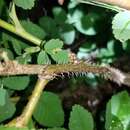Comprehensive Description
provided by North American Flora
Rosa durandii Crepin, Bull. Soc. Bot. Fr. 22: 19. 1875
Rosa kamlschalica A. Gray, Proc. Am. Acad. 8: 382. 1872. Not R. kamtschatica Vent. 1800.
Stem terete, brown, 2-3 m. high, armed with very stout prickles, which are about 1.5 cm. long, very flat, curved, puberulent; branches pubescent and densely glandular-hispid; stipules 2 cm. long, copiously glandular on the back, densely glandular-ciliate, the upper dilated, the free portions lance-ovate, somewhat falcate ; petiole and rachis unarmed, pubescent and very glandular; leaflets 5-9, broadly oval, rounded at the base, acute at the apex, glabrous above, densely glandular-granuliferous beneath, double-toothed with gland-tipped teeth; flowers solitary or 2 or 3 together; pedicels 1-2 cm. long, densely glandular; hypanthium smooth or slightly glandular at the base, globose, in fruit 12-15 mm. broad; sepals entire, broadlylanceolate, caudate-attenuate, about 1.5 cm. long, glandular on the back, tomentose on the margins and inside, in fruit erect and persistent; styles distinct, persistent, not exserted.
Type locality: Oregon.
Distribution: Oregon (and western Idaho?).
- bibliographic citation
- Per Axel Rydberg. 1918. ROSACEAE (conclusio). North American flora. vol 22(6). New York Botanical Garden, New York, NY

